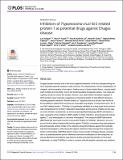Files in this item
Inhibitors of Trypanosoma cruzi Sir2 related protein 1 as potential drugs against Chagas disease
Item metadata
| dc.contributor.author | Gaspar, Luís | |
| dc.contributor.author | Coron, Ross P. | |
| dc.contributor.author | Kongthoo Lin, Paul | |
| dc.contributor.author | Costa, David M. | |
| dc.contributor.author | Perez-Cabezas, Begoña | |
| dc.contributor.author | Tavares, Joana | |
| dc.contributor.author | Roura-Ferrer, Meritxell | |
| dc.contributor.author | Ramos, Isbaal | |
| dc.contributor.author | Ronin, Céline | |
| dc.contributor.author | Major, Louise L. | |
| dc.contributor.author | Ciesielski, Fabrice | |
| dc.contributor.author | Pemberton, Iain K. | |
| dc.contributor.author | MacDougall, Jane | |
| dc.contributor.author | Ciapetti, Paola | |
| dc.contributor.author | Smith, Terry K. | |
| dc.contributor.author | Cordeiro-da-Silva, Anabela | |
| dc.date.accessioned | 2018-02-13T12:30:09Z | |
| dc.date.available | 2018-02-13T12:30:09Z | |
| dc.date.issued | 2018-01-22 | |
| dc.identifier | 252276932 | |
| dc.identifier | 8c03d29e-8a7d-4a3b-bce1-b8dd5f487bf0 | |
| dc.identifier | 85041585443 | |
| dc.identifier | 000424022700042 | |
| dc.identifier.citation | Gaspar , L , Coron , R P , Kongthoo Lin , P , Costa , D M , Perez-Cabezas , B , Tavares , J , Roura-Ferrer , M , Ramos , I , Ronin , C , Major , L L , Ciesielski , F , Pemberton , I K , MacDougall , J , Ciapetti , P , Smith , T K & Cordeiro-da-Silva , A 2018 , ' Inhibitors of Trypanosoma cruzi Sir2 related protein 1 as potential drugs against Chagas disease ' , PLoS Neglected Tropical Diseases , vol. 12 , no. 1 , e0006180 . https://doi.org/10.1371/journal.pntd.0006180 | en |
| dc.identifier.issn | 1935-2735 | |
| dc.identifier.other | crossref: 10.1371/journal.pntd.0006180 | |
| dc.identifier.other | ORCID: /0000-0001-5287-4488/work/51010274 | |
| dc.identifier.uri | https://hdl.handle.net/10023/12710 | |
| dc.description | The research leading to these results has received funding from: the European Community’s Seventh Framework Programme under grant agreement No.602773 (Project KINDReD) and Fundação para a Ciência e Tecnologia (FCT)/ Ministério da Educação e Ciência (MEC) cofunded by FEDER, partnership agreement PT2020, through the Research Unit No.4293. LG was supported by the Fundação para a Ciência e Tecnologia through grant SFRH/BD /81604/2011. DMC was supported by KINDReD-PR 301404-B D III scholarship. JT is an Investigator FCT funded by National funds through FCT and co-funded through European Social Fund within the Human Potential Operating Programme . The authors thank the EPSRC UK National Mass Spectrometry Facility at Swansea University for high resolution mass spectral analysis on all the new compounds. | en |
| dc.description.abstract | Chagas disease remains one of the most neglected diseases in the world despite being the most important parasitic disease in Latin America. The characteristic chronic manifestation of chagasic cardiomyopathy is the region’s leading cause of heart-related illness, causing significant mortality and morbidity. Due to the limited available therapeutic options, new drugs are urgently needed to control the disease. Sirtuins, also called Silent information regulator 2 (Sir2) proteins have long been suggested as interesting targets to treat different diseases, including parasitic infections. Recent studies on Trypanosoma cruzi sirtuins have hinted at the possibility to exploit these enzymes as a possible drug targets. In the present work, the T. cruzi Sir2 related protein 1 (TcSir2rp1) is genetically validated as a drug target and biochemically characterized for its NAD+-dependent deacetylase activity and its inhibition by the classic sirtuin inhibitor nicotinamide, as well as by bisnaphthalimidopropyl (BNIP) derivatives, a class of parasite sirtuin inhibitors. BNIPs ability to inhibit TcSir2rp1, and anti-parasitic activity against T. cruzi amastigotes in vitro were investigated. The compound BNIP Spermidine (BNIPSpd) (9) , was found to be the most potent inhibitor of TcSir2rp1. Moreover, this compound showed altered trypanocidal activity against TcSir2rp1 overexpressing epimastigotes and anti-parasitic activity similar to the reference drug benznidazole against the medically important amastigotes, while having the highest selectivity index amongst the compounds tested. Unfortunately, BNIPSpd failed to treat a mouse model of Chagas disease, possibly due to its pharmacokinetic profile. Medicinal chemistry modifications of the compound, as well as alternative formulations may improve activity and pharmacokinetics in the future. Additionally, an initial TcSIR2rp1 model in complex with p53 peptide substrate was obtained from low resolution X-ray data (3.5 Å) to gain insight into the potential specificity of the interaction with the BNIP compounds. In conclusion, the search for TcSir2rp1 specific inhibitors may represent a valuable strategy for drug discovery against T. cruzi. | |
| dc.format.extent | 30 | |
| dc.format.extent | 11484790 | |
| dc.language.iso | eng | |
| dc.relation.ispartof | PLoS Neglected Tropical Diseases | en |
| dc.subject | QH301 Biology | en |
| dc.subject | RM Therapeutics. Pharmacology | en |
| dc.subject | NDAS | en |
| dc.subject | SDG 3 - Good Health and Well-being | en |
| dc.subject.lcc | QH301 | en |
| dc.subject.lcc | RM | en |
| dc.title | Inhibitors of Trypanosoma cruzi Sir2 related protein 1 as potential drugs against Chagas disease | en |
| dc.type | Journal article | en |
| dc.contributor.sponsor | European Commission | en |
| dc.contributor.institution | University of St Andrews. School of Biology | en |
| dc.contributor.institution | University of St Andrews. Biomedical Sciences Research Complex | en |
| dc.identifier.doi | https://doi.org/10.1371/journal.pntd.0006180 | |
| dc.description.status | Peer reviewed | en |
| dc.identifier.grantnumber | en |
This item appears in the following Collection(s)
Items in the St Andrews Research Repository are protected by copyright, with all rights reserved, unless otherwise indicated.

